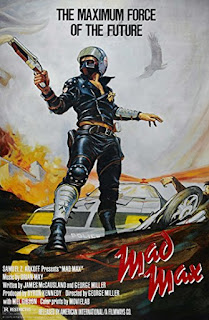 |
| Mad Max (1979) |
Right off the bat, it's very refreshing for this movie to be set in Australia. It's not just because I'm being patriotic, but there's just something about the countryside of Australia that's just so different than anything I've seen in another movie before. A lot of other movies that are set in Australia will go for the outback itself, or Sydney, or the Reef, but this is a far more realistic look at what the majority of Australia (or at least the parts of Australia I know) look like, and it's weirdly nostalgic for me. Yes, maybe I am just being patriotic, but I'm happy that an Australian movie did this well. Also, I'm equally glad that the entire cast is Australian or New Zealander. A lot of times when there's an Australian character in a movie it's played by an American putting on an accent that just sounds like the stereotypical Aussie accent that's nothing like what we actually sound like and instead sounds like a caricature of Crocodile Dundee, but this is much better.
 |
| Mel Gibson as Max Rockatansky |
The setting of this movie, beyond just being Australia, is another interesting aspect of the movie. We can tell that society is on the tipping-point of falling into complete chaos, but we're never told exactly what happened to cause it. We don't need to for this story, it's a lot more personal than I was expecting, but I still would have liked some explanation, especially considering how powerful the biker gangs have become. Considering that they're the driving force behind the conflict, the fact that we're never told how they rose to power is an issue, and I think I would have enjoyed some backstory here. It would have been somewhat unrealistic to have the characters delivering exposition to each other, but they could have dropped hints either through passing dialogue or visual indicators as we drive across the country. Something like that would have been good for some world-building, which a future civilisation movie like this really does need.
 |
| Joanne Samuel as Jessie Rockatansky |
So, the movie is weirdly divided into three chunks, beyond the traditional three-act format. The first half of the movie shows us how society works now, at least when it comes to the police force and the bikers. Using Nightrider here is a great way to show us how screwed up everything is whilst entertaining us with some classic over-the-top bogan action, which is always fun. At the halfway mark, the film takes a turn, which it really needed to, and it becomes something of a road-trip movie with Max and his family just living their lives and occasionally running from the bikers. These scenes are especially effective at endearing us to Max and Jessie, and it's through their interactions in this part of the film that really sell us on their relationship. It helps that Gibson and Samuel have great chemistry with each other, and that's what makes it especially heartbreaking when the last 20 minutes rolls around and the movie turns into a revenge-story. This final part of the film is where Gibson is at his finest, as he turns from this caring family man into a remorseless revenge machine. Max is not the same person by the end of the film as he was in the beginning, and movies like that are always my favourites.
 |
| Vincent Gil as The Nightrider |
The three different chunks of the film have their pros and cons, and I don't mean comparing them to each other. The movie is somewhat segmented as we follow Max's story, which there's nothing wrong with; personal stories are always more inherently interesting. The second half of the movie is way more interesting to watch than the first, as we tighten our focus and specifically deal with Max. Unfortunately, this does mean that certain plot threads from earlier sections of the movie get abandoned without remorse. Fifi was a great character, at least, I thought so, and after the halfway mark, we never see him again, even when Max returns to the MFP. It would have been nice to see him at least once at that point. Not to mention, this film has one of the quickest endings I've ever seen, and we don't get the closure I was hoping for, including for things that happen after the halfway mark. It's tough without spoiling things, but the fates of certain characters are just left up in the air with no resolutions, and especially for this personal story, we kinda needed those answers.
 |
| Roger Ward as Fred "Fifi" Macaffee |
However, some great character interactions and a lot of damn entertaining chase sequences stop Mad Max (1979) from falling into the boring pile and instead make it a damn fun watch, despite one or two shortcomings. From what I've heard, this franchise just goes from strength to strength from here, and I hope that's true, since at the moment, this is really nothing more than a fun time, nothing too special all things considered. 7/10.

Tomorrow, they're back. It's Aliens.
No comments:
Post a Comment